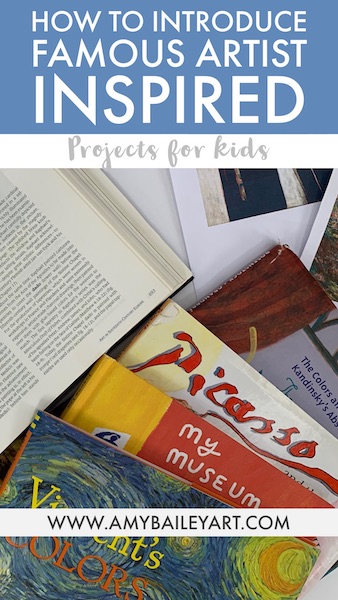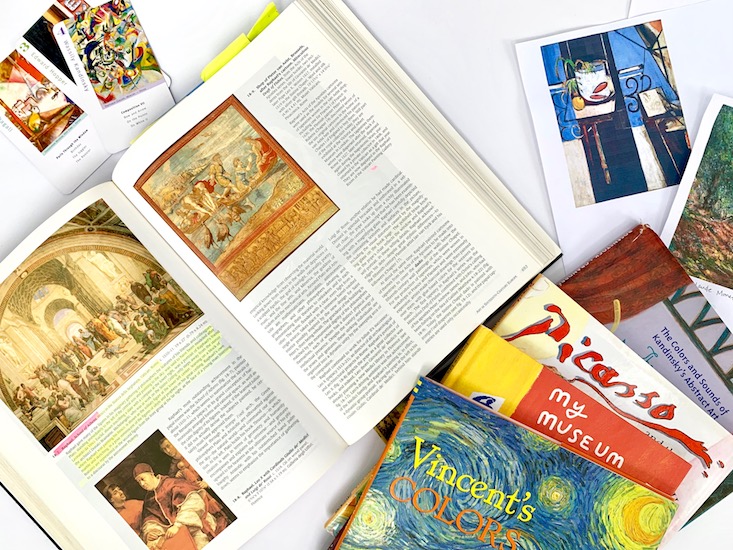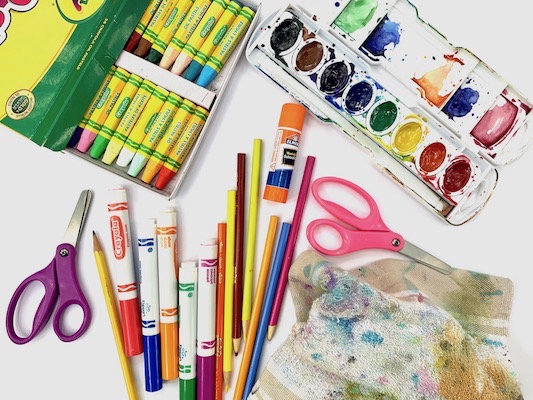Many parents and caregivers feel intimidated or under-qualified to introduce famous artists to kids, and as someone who has a degree in Art History and believes deeply in the value of kids being exposed to master artists and their works, I would like to help dispel any doubts or fears! There are so many amazing resources at your disposal.
Here are the exact steps that I used to introduce famous artists projects when I was a teacher and I that I use now in all the artist themed projects you find on this site. Feel free to take or leave what resonates with you.

1. Gather resources to Introduce Famous Artists
First, I try to find a children’s book that is about the artist. All of our brains love stories. When a child gets wrapped up in a story, they are put in a brain space that is more ready to create. Their attention and curiosity can be ignited. Here is a pinterest board with a lot of my favorites. Here is a great series called “Portrait of an Artist”.
Showing a wide range of the artist’s work is the goal. I get these from books, prints or a quick google search, usually choosing a particular work to focus on and printing that one out.

2. Let the child respond to the story
After we finish the story, I let them respond. I usually just say, what did you think about that story? There are no wrong answers and I want their thoughts to be totally unguided by mine. I try carefully not to respond with correct/wrong language, listening intently, most often responding with, “I love listening to your observations.” or “I really enjoy hearing your thoughts on this.” or “Thank you so much for sharing.”
I try to let my eyes and body language show that this is important and I think what were talking about has weight. Acknowledging and thanking them for sharing communicates that their observations are important. I hope this doesn’t sound robotic.
My hope is that the conversation is child led.
They are not bringing the same view that we are to the table. Unlike us, they (most likely) have no preconceived ideas of this artist. They may or may not know what artists are in prestigious museums, or who people think was mentally ill, or nearsighted or on substances or any of that.
Such wonderfully, beautifully clean slates are such a gift! Feel free to show your wonder and delight at theirs!

3. Brief artist bio
Next, I try to do a VERY brief bio on this artist. Try to reign it in over the little details to keep their attention for the real fun – making art! So, hit the high points… or better yet point. Use lots of questions, “Did you know __________?! Can you believe that?!”
Laughter is so great to mix in whenever possible.
The aim is to make this as fun as possible and not dry or boring at all.
4. Let the child respond to the artist’s work + highlight key vocab
I like to have pictures printed off or have art cards so kids can hold them in their hands. This can be really in depth if your child is super into it, but if they are very young or if they are not “into” it that day, don’t push it. That’s fine!
The goal here for me is exposure, exploration, an introduction.
Your lightness, curiosity and excitement make this engaging for them. All the while your are dropping in little gems, planting small seeds for a way of interacting with artwork, questions to ask, vocabulary to start to take hold in that amazing, spongy, beautiful brain of of theirs.
At this point, feel a little more free to ask some guiding questions and definitely hit the element and/or principle of art and design that you want them to repeat!
Again, there are no correct or incorrect answers when we introduce famous artists, only observations and exploration.
Here are some examples of questions that may be helpful:
What do you notice most in the picture?
Is there anything you like or dislike about it?
What do you think is happening?
Does it remind you of anything?
Do you feel anything when observing the artwork?
What do you think about a particular part of the painting?
Does anything stand out?
Would you want to be in the picture? Why or why not?
What do you think of how the artist used (insert element of art) in this painting?
Bonus step: have some extra fun!
Pose like someone in the painting. Think of silly captions. Make up a fun story. Ask questions they don’t expect, like “how do you think he breathes with such a tight collar on? What if he’s looking out the window because his friend is out there making funny faces at him?”
Obviously, there’s a time and a place. Please use discretion. I’m definitely not suggesting we make fun of heavier themes that can be found in artworks, ie human suffering or topics of that nature.

5. Make art!
Next, I draw the attention to the particular work/works we are focusing on, pointing out key elements and show the example project. Going over the steps quickly and reassuring that we will be doing it together, step by step.
Looking for fun, easy famous artist inspired projects?
Head to the “art projects” sections of the blog here and you will find lots! I do my very best to create simple, easy to follow projects with basic supplies you can always have on hand. Here is a complete list of my favorite art supplies for kids, each item has a direct link to that supply at my favorite place to buy art supplies!


